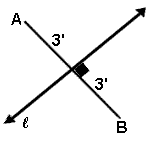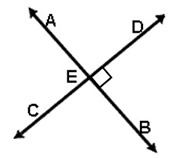 acute angle
acute angle |
An acute angle is an angle whose measure is greater than 0° and less than 90º. |
 acute triangle
acute triangle |
An acute triangle is a triangle that has three acute angles. |

∠1 and ∠2 are adjacent
∠1 and ∠ABC are not adjacent |
Adjacent angles share a common vertex, a common side and no common interior points (they do not overlap). |
 altitude for an obtuse triangle
altitude for an obtuse triangle |
The altitude (height) of a triangle is a line segment extending from any vertex of a triangle perpendicular to the line containing the opposite side. |
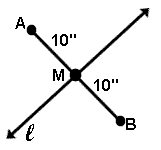 M is the midpoint of
M is the midpoint of 
|
Bisector of a line segment is any line (or subset of a line) that intersects the segment at its midpoint.
Alternate definition: Bisector of a line segment is any line (or subset of a line) that divides the segment into two congruent segments. |
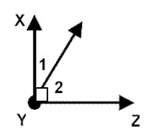
∠1 and ∠2 are complementary
|
Complementary angles are two angles the sum of whose measures is 90º. (Complementary angles need not be adjacent angles.) |
 congruent angles
congruent angles |
Congruent angles are angles of the same measure. |
|
Congruent segments are segments of the same length (measure). |
 congruent triangles
congruent triangles |
Congruent triangles are triangles whose corresponding angles and sides are congruent. (They are exactly the same size and shape.) |
 equiangular triangle
equiangular triangle |
An equiangular triangle is a triangle which has three congruent angles. |
 equilateral triangle
equilateral triangle
|
An equilateral triangle is a triangle with three congruent sides. |
 isosceles triangle
isosceles triangle |
An isosceles triangle is a triangle with two congruent sides. |
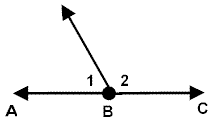 linear pair
linear pair |
A linear pair of angles are adjacent angles whose non-common sides are opposite rays (form a straight line). The sum of the measures of the angles in a linear pair is 180º. Unlike supplementary angles, a linear pair MUST be two adjacent angles. |
|
Midpoint of a line segment is the point on that line segment that divides the segment two congruent segments. |
 obtuse angle
obtuse angle |
An obtuse angle is an angle whose measure is greater than 90º and less than 180º. |
|
The perpendicular bisector of a segment is a line (or subset of a line) that bisects the segment and is perpendicular to the segment. |
|
Perpendicular lines are two lines which intersect to form right angles. |
 right angle
right angle |
A right angle is an angle whose measure is 90º. |
 right triangle
right triangle |
A right triangle is a triangle containing one right angle. |
 scalene triangle
scalene triangle |
A scalene triangle is a triangle with no congruent sides. |
 straight angle
straight angle |
A straight angle is an angle whose measure is 180º. It looks like a straight line. |

∠1 and ∠2 are supplementary
|
Supplementary angles are two angles the sum of whose measures is 180º. (Supplementary angles need not be adjacent.) |
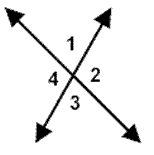
∠1 and ∠3 are vertical angles
∠2 and ∠4 are vertical angles |
Vertical angles are two nonadjacent angles formed by two intersecting lines. Vertical angles are equal in measure. |
















